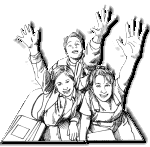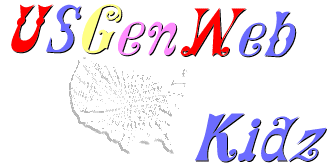Teachers & Parents
So you have no idea where to start?

That's Ok you start with You! That's right you are the best place to start, you already have lots of information to get you started on your way. That is the best way to do genealogy working backwards. From you and into the past!
will help guide you on your way to "Rooting" for your ancestors. So to
start with you will need a notebook. Take the first page and number it at the
top #1. Then you will write down all the information that you know about
yourself. Start with your full name, written with your surname (last name)
first, all in capital letters. Like this:
- DOE, John Quincy
Like this: 12 Nov. 1990
You Need to write all your dates like this when doing Genealogy. This is the uniform way that Genealogist keep dates. You will see how it helps keep the dates correct when you start to do more advanced research. But for now just remember that you are trying to keep your records uniform from the start.
On the next line place the location of your birth. Write the "places" in this order: City/Township, County, State, Country. Try to have as much of the location as you know.
Example of how to write a place:
- (Aurora, Arapahoe County, Colorado, USA)
Your page should look something like this:
#1
- DOE, John Qunicy
- born 12 Nov. 1990
- Little Town, Arapahoe Co., Colorado, USA
Ok lets do some more. On the Next line you need to place the #2 and next to it place "Father" and then write your father's full name. On the line below that place his birth date, remember to write it just like you did for your's, with the Date then the Month and then the Year. On the next line you can add his place of birth.
I hope you are still with me, we are just getting warmed up. Ok lets go to the next line and if you know when your parents were married you need to add the date and place of their marriage.
Now on the next line you place the #3 and "Mother" and write your mother's full name before she got married. This is her "Maiden Name". on the next line you can add her birth date. and below that you can add her place of birth.So Now your page should look like this:
#1
- DOE, John Qunicy
- born 12 Nov.1990
- Little Town, Arapahoe Co., Colorado, USA
- #2 Father: DOE, James Quincy
- born 01 Jan1950
- Another City, Arapahoe Co., Colorado, USA
- Married 14 Feb. 1975
- Another City, Arapahoe Co., Colorado, USA
- #3 Mother: SMITH, Jane Mae
- born 11 Jun. 1955
- Another City, Arapahoe Co., Colorado, USA
Can you see how this makes the last names stand out? Do the dates look easy to read also? Try to remember that the standard form for genealogy has been used for a very long time. As you will be in contact with other genealogists. So having a uniform way of formatting the information is necessary.
Ok now you will get to really start "Rooting". Go to your next page and number it #2. You fill this one out just like the one for you, but you will use only information on Your father. Place his name at the top, and then below that his birth date, and place he was born.
If you don't have this information that is ok you can ask him personally. You can do an interview, of your father. This is the best place to get information about a person, ASK while you can, it is much harder to get this same information when the person is no longer here. It is a good idea to interview all of the older members of your family that you can. They may even provide you with valuable resources for your research, but you will never know if you don't talk to them.There are places to get this information if you can't do an interview. I will go into that in the intermediate & advanced pages.
Here are the questions you can ask when you interview:
- When were you born?
- Where were you born?
- What is your Father's name? (this will be #4)
- When did he get Married?
- What is your Mother's maiden name? (this will be#5)
- When was she born?
- Where was she born?
- Do you know your Father's Father's name? (this will be #8)
- His Place of birth?
- His date of death If no longer alive?
- When he was married?
- Your Father's Mother's name? (this will be #9)
- Her date of birth?
- Her place of birth?
- Her date of death if no longer alive?
- The names of his Brothers and/or Sisters?
- When were they born?
Now do the same interview with your Mother. Her father will be #6. Your Mothers Father's Father is #12, and Fathers Mother is #13. Your Mother's Mother is #7, Her Mother's Father is #14, and her Mother's Mother is #15. All of these should be on pages with the corresponding Number.
If you can't get all the answers to these questions that is OK. You can search for them in other places. Use these for any interview you do, they will help. You could also ask the person you are interviewing to tell you something about what it was like when they were growing up.
Ok now you can print out one of the pedigree charts on the Forms Page. Once you have it printed out you can fill it in using your notebook. Place your name and information in #1 and you fathers in #2. just like you have them in your notebook. Each line on the pedigree represents a page in your notebook. If you notice All the Male members of your family go on the even lines and all the female members go on odd numbered lines. So your Mother goes on line # 3 and her father on line # 6, her mother on line # 7 and so on. Here is an Example of a Pedigree. Once you get this filled in you have completed the first steps in Genealogy. Congratulations!
This is the basics of genealogy. the next step is to learn about the other forms and how to keep your records so you will be able to follow your lines with out a lot of extra confusion.
Now you can go to the Next step
Intermediate Genealogy.
Q: When did the Revolutionary War end? A: September 3, 1783
It's true that Charles Cornwallis surrendered on October 17, 1781—formally signing articles of capitulation two days later, effectively ending full-scale combat operations in the colonies. But the war didn't officially end until nearly three years later. In November 1782, British and American representatives signed preliminary peace terms in Paris. However, fighting continued until September 3, 1783, when Britain formally recognized American independence with the Treaty of Paris. Notice for Teachers and Librarians! Free Teleconference for K-12 Libraries was broadcast Friday,
October 10, 2003 "Digital Treasures for Teaching and Learning" available now for your review on streaming
video via the Web. Read more…
I would be glad to add any additonal lesson plans that you would like to send to me.
Stuff for Kids
For Teachers
Please let me know If you find any problems with the links on this site or if you have an idea for this page. You can email
Stuff for Kids
Q: Where was the first ski area and when did it open?
A: Howelsen Hill in 1915
Read more…
For Teachers
FREE Calendar download


